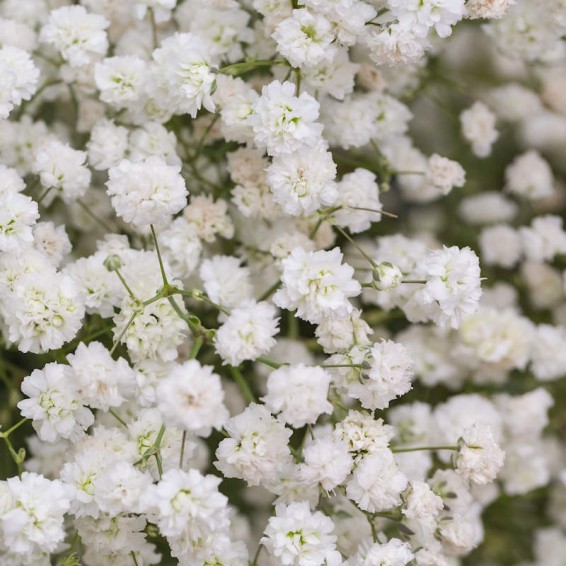Perennial Baby's Breath Seeds
Gypsophila paniculata
- HOW TO GROW
- FAST FACTS
HOW TO GROW
Sowing: Direct sow in spring after the soil has warmed to about 70 degrees F. Press the seed into the soil's surface, since it requires light to sprout; keep the soil moist until it germinates, which usually occurs in 10-15 days. To start indoors, sow the seed in flats 4-6 weeks before the last frost; keep the soil lightly moist until germination, and transplant the seedlings outdoors as soon as the weather allows. This plant grows well in rich, light soils.
Growing: This plant can tolerate some drought, though it grows best with regular watering as it develops and begins to bloom. Because of its extensive root system, the plant often develops rather slowly; blooming may not begin until its second or third year of growth. Cut the foliage back periodocally for new growth and reblooming. This plant will self-seed readily at the end of the season, and can become rather weedy in certain areas; cutting the foliage down to ground level after blooming will help prevent this. Do not disturb the roots or attempt to transplant. Do not allow the soil to remain damp over winter, since this can cause rotting and disease. These flowers attract bees and butterflies and resist deer.
Harvesting: For fresh flowers, cut long stems of flowers that have just opened and place them in water immediately; strip the leaves that will fall below the water. These flowers also dry well.
Seed Saving: After blooming, each flower will develop a small round seed pod. As soon as the pods dry and contain mature black seed, shake them over a container to remove the seed. The entire plant can also be cut several inches above ground level and hung upside down, to allow the seed to fall as the plant dries.
FAST FACTS
Latin Name: Gypsophila paniculata
Species Origin: Eurasia
Type: Garden Flowers
Life Cycle: Perennial
USDA Zones: 1, 2, 3, 4, 5, 6, 7, 8, 9, 10, 11
US Regions: California, Mountain, Arid/Desert, Plains/Texas, Midwest, Northern, Northeast, Southeast
Seeds per Ounce: 32,000
Stratification: No Stratification
Germination Ease: No Stratification
Sunlight: Full Sun
Height: 30 Inches
Color: White
Bloom Season: Blooms Early Summer, Blooms Late Summer
Uses: Cut Flowers, Dried Flowers, Deer Resistant
DESCRIPTION
HOW TO GROW
Sowing: Direct sow in spring after the soil has warmed to about 70 degrees F. Press the seed into the soil's surface, since it requires light to sprout; keep the soil moist until it germinates, which usually occurs in 10-15 days. To start indoors, sow the seed in flats 4-6 weeks before the last frost; keep the soil lightly moist until germination, and transplant the seedlings outdoors as soon as the weather allows. This plant grows well in rich, light soils.
Growing: This plant can tolerate some drought, though it grows best with regular watering as it develops and begins to bloom. Because of its extensive root system, the plant often develops rather slowly; blooming may not begin until its second or third year of growth. Cut the foliage back periodocally for new growth and reblooming. This plant will self-seed readily at the end of the season, and can become rather weedy in certain areas; cutting the foliage down to ground level after blooming will help prevent this. Do not disturb the roots or attempt to transplant. Do not allow the soil to remain damp over winter, since this can cause rotting and disease. These flowers attract bees and butterflies and resist deer.
Harvesting: For fresh flowers, cut long stems of flowers that have just opened and place them in water immediately; strip the leaves that will fall below the water. These flowers also dry well.
Seed Saving: After blooming, each flower will develop a small round seed pod. As soon as the pods dry and contain mature black seed, shake them over a container to remove the seed. The entire plant can also be cut several inches above ground level and hung upside down, to allow the seed to fall as the plant dries.
FAST FACTS
Latin Name: Gypsophila paniculata
Species Origin: Eurasia
Type: Garden Flowers
Life Cycle: Perennial
USDA Zones: 1, 2, 3, 4, 5, 6, 7, 8, 9, 10, 11
US Regions: California, Mountain, Arid/Desert, Plains/Texas, Midwest, Northern, Northeast, Southeast
Seeds per Ounce: 32,000
Stratification: No Stratification
Germination Ease: No Stratification
Sunlight: Full Sun
Height: 30 Inches
Color: White
Bloom Season: Blooms Early Summer, Blooms Late Summer
Uses: Cut Flowers, Dried Flowers, Deer Resistant




